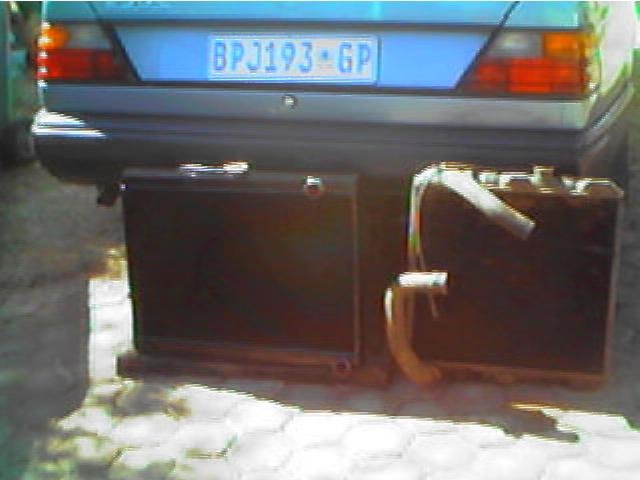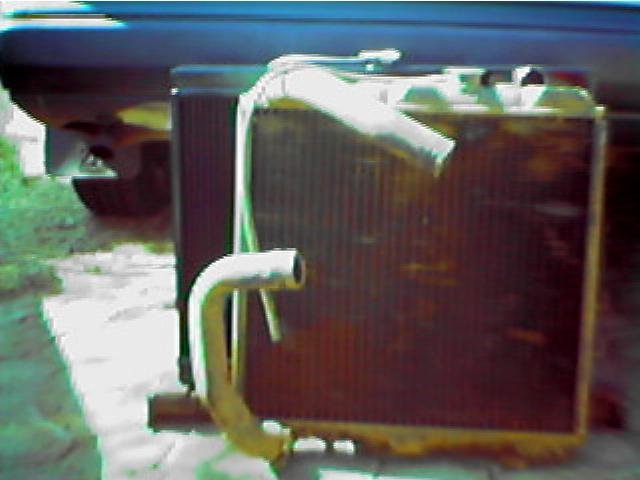I tried to fit the old radiator and this is the result. The fan pushes into the radiator, I could push the radiator back about 3mm but the fan would still be too close for comfort.
Very bad pictures, but if you look carefully you'll see the fan pushing right on to the radiator.
Custom radiator needed to be made. Here is the result!
Old Radiator New Radiator
Dimensions: 450mmX460mm (core) 480mmX600mm (core)
Surface area: 2 070cm square 2 880cm square
Capacity: 10.4 liters Calculated as 13.9 liters
My initial thought was to fit a very thick radiator into the "nose" and thus increasing the capacity of the radiator from 10.4l to about 22l. The radiator would have to be slightly smaller in width as well as in height, but I thought the thickness would more than make up for the reduction in the size. I will also save on space inside the engine compartment and just make a "funnel" from the fan to the radiator thus forcing more airflow through the radiator. Well with all these plans in my mind I went to the radiator shop and here follows:
The guy at Sterling radiators said the following: It is of no use to increase the volume of the radiator if the surface area is not increased. A radiator 100mm thick with the same dimensions as the original will be far less efficient than a radiator 48mm thick with a larger surface area. (The assistance, patience and help I got from him was really incredible.) As you can see the surface area is now 39% larger with a theoretical increase in capacity of 6 liters. (The actual capacity was in fact less than calculated.)


Radiator specs on the left. Remember the brackets are BEHIND the radiator. (I.e. the pipes are connected to the opposite side to where the brackets are.) On the right is a picture comparing the old and new radiator side by side and below the old radiator sits in front of the new one. (To show the increase in width, they are exactly the same height physically but the new one's core is slightly higher.)

Well the radiator seems to be working just fine. (Actually better than fine. Even after a good long drive the bottom of the radiator stays cool to the touch, while the temperature gauge never moves from the 80-90 degrees mark I guess that is why there are such things as thermostats.) I had to cut the "bracket" that held the original air filter housing away to allow the wider radiator to fit. The distance between the two front "legs" of the chassis is exactly 634mm, so the radiator fits just between the chassis legs. Unfortunately while I was using the angle grinder to do the cutting I severed the brake line/pipe as well. That meant that I had to buy a brake pipe with correct thread to replace the brake pipe before I could take her for a test drive.
Bottom water inlet
As can be seen from the photo showing the right engine mounting (near the top) the water inlet pipe bends down. If I have cut the mounting bracket away from the chassis and moved it towards the rear it would not have been a problem, but as I did not want to, and chose the option of making an "adapter" it meant that the space between the mounting bracket and water inlet is very small and the water pipe has to bend so sharp that it restricts water flow. I therefore asked Gideon to make an inlet that comes out straight. He used 2mm exhaust pipe and as the base 5mm sheet metal. He drilled out the hole in the sheet metal, welded all together and it went into the lathe to machine the mating surface. Stuck the old and new one together and drilled the holes for the bolts. Here is a photo of the old and new water inlet next to each other. (My contribution - painting it!)
On the right is the manufactured pipe and on the left the original inlet.